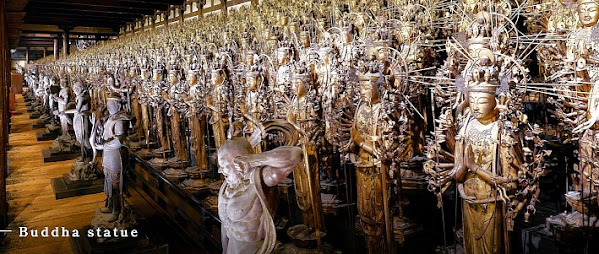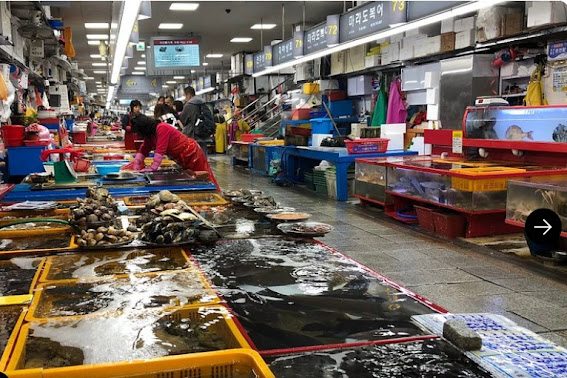OSAKA
DAY #1: Wednesday
On the first day, we are on our own. Our Tour doesn't begin until at 5:30 PM. I asked ChatGPT about what to do in Osaka. It suggested Osaka Castle and Dotonbori. Each is about 2-1/2 miles from the Conrad.
The present castle tower is a ferro-concrete reconstruction rebuilt in 1931 of the 1583 version. Entirely modern on the inside, it houses an informative museum about the castle's history and Toyotomi Hideyoshi.(A ticket costs 600 yen. Free rental of audio guide devices in Japanese, English, Korean, and Chinese)
Lunch (optional): Slightly off our return walk is an economical Japanese restaurant MatsuyaYodoyabashi. Adventuresome? Check out the pictures on this menu! It's NOT sushi.
https://www.matsuyafoods.co.jp/english/menu/
Day #2: Thursday
This classic city has 2,000 temples and shrines. In the morning, we have a little over an hour to drive from Conrad to Kinkaku-ji in Kyoto.
The Kinkaku-ji "Temple of the Golden Pavilion" is bathed in gold leaf and capped by a golden phoenix, sits in a landscape design meticulously preserved since the 1400s, with a strategically placed pond that hauntingly reflects the shimmering golden temple.
Kinkakuji is a Zen temple as the 1408 retirement villa of the shogun Ashikaga Yoshimitsu, Temples are the places of worship in Japanese Buddhism. Virtually every Japanese municipality has at least one temple, while large cultural centers like Kyoto have hundreds.
In 1191, the Zen sect was introduced from China. Its complicated theories were popular particularly among the members of the military class. According to Zen teachings, one can achieve self enlightenment through meditation and discipline.
After we drive a half-hour to the Sanjusangen-do, another Buddhist temple in Kyoto's Higashiyama District – officially called "Rengeo-in" ("Hall of the Lotus King").
Pictures are forbidden in its long and majestic main wooden hall known for sheltering 1,001 statues of Kannon, the deity of compassion.
After lunch at a local restaurant, we attend a traditional Japanese Taiko drumming experience
Before returning to Conrad, we explore around of Kyoto.
DINNER is back at Conrad (included)Day #3: Friday
Today, we are visiting Todai-ji (Great Eastern Temple), a Buddhist temple complex that was once one of the city's powerful Seven Great Temples. It serves as headquarters of the Kegon school of Buddhism in Japan and is part of the UNESCO World Heritage Site officially called the "Historic Monuments of Ancient Nara,"
The world's largest bronze statue of the Buddha Vairocana.
Nara is 45 minutes from the Conrad
Until recently, Todaiji's main hall, the Daibutsuden (Big Buddha Hall), held the record as the world's largest wooden building, despite the fact that the present reconstruction of 1692 is only two thirds of the original temple hall's size. The massive building houses one of Japan's largest bronze statues of Buddha (Daibutsu), 15 meters tall.

- Lunch is at a local restaurant.
After we visit to the Kasuga-Taisha (known as the Kasuga Grand Shrine) a Shinto shrine found in Nara. Known for its many bronze and stone lanterns that lead up to the shrine, the Shrine has been rebuilt several times since its establishment in 768 CE.
- On the way to the shrine, pass through Deer Park where more than 1,200 wild sika deer roam.
Day #4: Saturday
AM: After breakfast sightsee in Osaka by motor coach, walking tour and visits to local markets.
Lunch at a local restaurant,
Early PM: Enjoy a walking tour through one of Osaka's local markets. We a couple of hours of FREE TIME to explore these markets
I am not sure which market that Tauck will provide for our FREE TIME but here is few good introduction about what we should know
Local Markets in Osaka - Something for everyone
Tips Before Going to Market in Osaka
Know Your Markets: Each market in Osaka, whether Kuromon Ichiba or Korea Town, has its unique flair. Research beforehand to align your visit with your interests.
Cash is King: Many shops or stalls and local shops in these markets prefer cash transactions. Ensure you have enough yen to cover your purchases.
Timing is Key: Some markets and seafood restaurants, like the Kuromon Ichiba, are known for their fresh fish and seafood. Visiting in the morning ensures you get the freshest produce.
Explore Local Foods: Take advantage of street food and fresh market foods. Each market offers a delicious variety of snacks and dishes.
Respect Local Etiquette: Remember, these markets are part of the daily life of local homeowners and business owners. Be respectful of their customs and business operations. They also don't like bargaining over price.
Late PM: Drive to the port of Osaka,
where Le Soleal awaits.
Day #5: Sunday
The first stop of the ship is on the old merchant town of Kurashiki. We will walk along the Bikan Historic Quarter for a walking tour of its historic quarter, where warehouses, shops, and mills remain virtually unchanged by time (see video below)
The Ohara Museum of Art is Japan's oldest private museum of Western art in a striking structure like ancient Rome or Greek-inspired building tucked behind a lush plant-covered stone wall. The museum houses western art such as El Greco, Monet, and Gaugin, as well as modern and contemporary Japanese and Western art, works by leading folk artists, and valuable antiques from Egypt and Asia.
After lunch, we Ferry to Naoshima, exclusively devoted to art installations and the work of the world-class architect Tadao Ando.
Naoshima Island is known for its many contemporary art museums:
- Chichu Art Museum (literally, "in the earth") houses a number of site-specific installations by James Turrell, Walter De Maria, and paintings by Claude Monet.
- Designs by Tadao Ando located commanding view of the island has various exhibits and facets of the museum's architecture and Benesse House
- Naoshima Fukutake Art Museum, with an outdoor sculpture garden
- James Bond museum, inspired as one of the settings for the 2002 Bond novel The Man with the Red Tattoo
Back onboard ship, tonight is captain's dinner, I suspect by jacket and tie as the ship sails to Hiroshima.
The Hiroshima Peace Memorial is the only structure left standing near the hypocenter of the first atomic bomb on 6 August 1945 at the condition right after the explosion. The Genbaku Dome has been preserved as a ruin as a stark and powerful symbol of the most destructive force ever created by humankind. This silent structure is the skeletal form of the surviving remains of the 1914 Hiroshima Prefectural Industrial Promotional Hall.
The property can be observed from the outside of the periphery fences and its external and internal integrity is well maintained. The buffer zone, including Hiroshima Peace Memorial Park, is defined both as a place for prayer for the atomic bomb victims as well as for permanent world peace.
The Memorial is designated as a historic site under Japanese 1950 Law for the Protection of Cultural Properties, and is managed by Hiroshima City. After lunch at a local restaurant serving regional fare, we can choose to visit the iconic Miyajima-Itsukushima Shrine that seems to float on water (a photographer's dream).
Nanrakuen Garden is a popular place for tourists and locals alike to visit for leisurely walks and casual photo shoots. The best time to visit is during the spring or fall, when the weather is mild and the flowers are in bloom.
Management building shop
Free rest area
 |  |
Mountain house

Tea room
Sukiya-style tea room is in the back of the mountain house.

The front is made of bamboo curtains.
Back on the ship, the Le Soleal heads from Uwajima to Kakoshima
Our Excursion choice for the today is a visit to the Sengan-en Garden, a traditional Japanese garden and stately home in Kagoshima, passed down in the Shimadzu family for over 350 years. The charming garden boasts spectacular views of Sakurajima across the bay, while the house provides a glimpse into the lifestyle of a powerful feudal lord.
On the ship the rest of the afternoon and evening, we are on our own, maybe on the heated sea-water pool as Le Soleal heads for Nagasaki.
NAGASAKI
After lunch aboard ship, return for our excursion choice on the Mt. Inasa Ropeway , which takes visitors from Nagasaki to the top of Mt. Inasa, rising to the west of the city.
Return to the ship for dinner, and continue your cruise to Busan.
a tour of the renowned Jagalchi Fish Market, a traditional seafood market on Busan's waterfront, and the largest in the country. In Korea as in Japan, seafood has been a mainstay of local cuisine for millennia, and your visit to this vast cooperative market offers an in-depth look at this longstanding cultural tradition.
Return to the ship this afternoon and set sail for Sakaiminato.
SAKAIMINATO/MATSUE
Day #11: Saturday
We arrive this morning in Sakaiminato, Western Japan's fishing industry center, for a visit to the Adachi Museum.We travel to Matsue , known as "the water city" for its river, canals, and setting on two lakes and the Sea of Japan (weather permitting, take in a great view of the city and beyond from its feudal fortress;
and our selected excursion option the Black Castle,
Back on the evening on the Le Soleal, the captain has his farewell dinner.
TOKYO
Day #12: Sunday
After breakfast, we leave Le Soleal for Tokyo with scenic drive from Maizuru to Kyoto. From Kyoto we aboard the Japanese bullet train Shinkansen to Japan's capital city, Tokyo.Most likely we will eat box lunches (bento boxes) on the train. We'll book into the Mandarin Oriental one of the best hotels in the world.
Its 2 bars and 10 restaurants include acclaimed French and Cantonese offerings. Other amenities include a swanky spa and a gym.
Here are a few comments a 2020 TripAdvisor
Amazing hotel - insane views of Tokyo and Mount Fuji This is a fantastic hotel and incredibly well located, a short distance from Tokyo Train Station and the Imperial Palace.
The views from the gym, breakfast, the 37th floor bar and our room - which included a distant view of the top of Mount Fuji in the latter two cases - were amazing.
The gym was on the 38th floor, open 24 hours and full of modern equipment and well stocked with water and clean towels. There were also sis facilities available although sadly we did not have the time to enjoy them.
Breakfast was epic - choice of a buffet, with egg options prepared to order or set menu. Both enjoyed on the 38th floor and therefore offering that great view.
Complimentary bikes were also available from the hotel for use around the city.
A local guide takes us a walking tour introducing the city's famed luxury shopping district of Ginza
That evening we our on our own for dinner. In past Tauck tours, we are so over-fed that we just have an appetizers and a local pub and walk (or bike) around the hotel.
The main complex of shrine buildings is about 4 miles from the Mandarin Oriental. Entry into the shrine grounds is marked by a massive torii gate, after a tranquil forest.
Meiji Jingu is one of Japan's most popular shrines. In the first days of the New Year, the shrine regularly welcomes more than three million visitors for the year's first prayers (hatsumode), more than any other shrine or temple in the country.
We can explore the Imperial Palace and Inner Grounds are only a mile from the Mandarin. The East Gardens of the Imperial Palace (Edo Castle Ruin) is open to the public (the Imperial Palace itself and Inner Grounds are not open to the public.
Day #14: Tuesday

















































